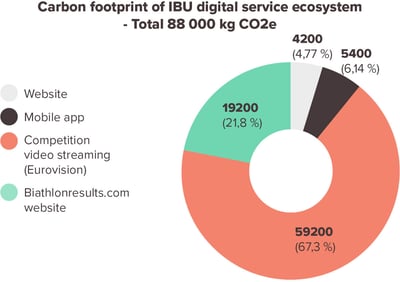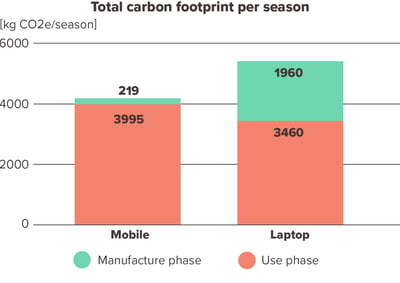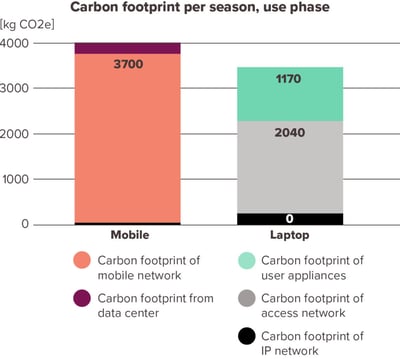The hidden costs of digital services
While fulfilling the ultimate quest of making lives easier, digital technology can help reduce emissions in society – according to the Exponential Climate Action Roadmap, by up to 15% when it comes to carbon. This kind of remarkable development can be achieved with a wide variety of small cross-industrial actions, such as optimizing transport logistic routes, supporting the use of renewable energy and minimizing waste in retail and production.
Digital solutions are used to achieve all that – and then some – in a more efficient way. However, even this coin has two sides – digital technology also carries an environmental footprint of its own.
It is estimated that ICT solutions cause between 1,4 percent to 5 percent of global greenhouse gas emissions.To make matters more challenging, available information about the environmental impact of digitalization is limited, scattered and sometimes even contradictory. In addition, the end-users of digital services have quite limited understanding of the data and energy use of digital services.
The interest towards carbon footprint of digital solutions is growing. The more insight we get about the emissions of digital value chain and infrastructure, the better we can design technologies in a way that does not cause global emissions to grow at a faster pace.
To solve the problem, we must first recognize it
Digital services, such as applications, streamed services and data transfer require physical devices and electricity to operate. Data centers, network infrastructure and wireless internet equipment all run on electricity and cause emissions. In addition, the manufacturing processes of user devices and infrastructure require natural resources and use scarce minerals.
Looking at the big picture, the energy consumption and carbon footprint of digital services can be decreased by improving the energy efficiency of data centers, information networks and end-user devices. Typically, at least the most successful digital solutions are used by a large audience, which means that even small decisions in the design phase can have substantial impacts. For example, a recent study by Bristol university estimated that even small tweaks in the design phase can significantly lighten the carbon footprint of YouTube.
Understanding the total energy economy of digital ecosystems, and how energy is consumed in different parts of it, helps make design decisions that minimize consumption along the digital value chain.
The carbon footprint of International Biathlon Union’s digital services
International Biathlon Union (IBU) recently launched a new digital ecosystem, including a new website and mobile application developed by Vincit to support the engagement and communication of the global biathlon community. As part of this project, IBU and Vincit measured the carbon footprints of both the IBU website and applications to understand what emissions are created and how much – as well as to identify ways to minimize them.
Based on a carbon footprint calculation conducted in Summer-Fall 2021, the total carbon footprint of the IBU’s digital ecosystem, including emissions from live video streaming, is approximately 88 000 kg CO2e. The carbon footprint of the website and app developed together with Vincit was estimated to 9 600 kg CO2e per season – this is approximately the same as the annual carbon footprint of a Finnish citizen, or driving 15 000 km with a petrol-driven car. The IBU web service and mobile apps are estimated to be used by 2 million users all around the world, which makes the carbon footprint per user relatively small. There is currently quite limited data available on the carbon footprint of similar digital services to compare with. Compared to carbon emissions of all IBU’s operations, digital services are not a significant source of emissions.

The carbon footprint of the digital ecosystem was calculated based on the electricity usage of the data transferred between the IBU web service and mobile application during the biathlon season. The amount of data was approximately 190 terabytes. In addition to data transfer, the calculation includes the emissions created by the production of the hardware needed for the servers and network infrastructure, as well as users' network devices. The calculation excluded the emissions of users’ devices, such as laptops or mobile phones, since the use of the IBU’s services on these devices is a small share of the overall use.
The data for the calculation was collected from the IBU / Vincit’s user data as well as from their service providers for the digital ecosystem. All service suppliers responded to the survey, but none of them was able to provide specific carbon footprint information or estimations on the energy consumption to serve as a basis of calculating their real impact to the IBU website and mobile apps. The final calculation was made based on publicly available data from research and sustainability reports, combined with the IBU’s insight on users.
The table below presents the total carbon footprint per season for mobile device and laptop users. For mobile users, the energy needed to transfer data in the mobile network is a major part of the total carbon footprint. For laptop users, the manufacturing phase emissions of network infrastructure are significant as well.

The manufacturing of the end-users’ home internet and wireless equipment plays a significant role in the carbon footprint of laptop users.

The location and country where IBU website and app are used determine the type of electricity the services run on. It was assumed that the energy used for data transmission is purchased from the market where the users are located. The emissions were calculated based on the country-specific emission factors for the 14 main markets of the IBU’s service. For the rest of the world, the average electricity production emission factor was used. Other emissions of data transfer were estimated based on public information on location of data centers.
Little deeds can go a long way
Even when the total carbon footprint per user is relatively small – as in this case – there are ways to reduce the emissions of digital services.
End users can reduce their emissions by:
- Switch to WiFi or LAN: Using a wireless or fixed network when using the services with a mobile phone or laptop at home or any location with a network.
- Check the source of power: Using renewable energy for powering the digital devices such as phones and laptops.
- Upgrade less often and remember to recycle: The emissions of manufacturing of network devices (such as internet boxes) is a significant part of the digital carbon footprint. This can be reduced by using the devices for as long as possible and recycling the devices appropriately.
Developers of digital services can reduce emissions by:
- Optimize asset size: Finding ways to reduce and optimize data transferred such as optimizing videos and images according to the end user device and screen size, optimizing video for different bandwidths and using lazy loading for images.
- Optimize capacity: Using on-demand capacity instead of dedicated capacity in data centers such as serverless offering in cloud.
- Switch to renewables: Preferring solutions which use renewable energy in for example data centers.
- Involve the supply chain: Engaging with companies that operate in the digital value chain and asking information about energy efficiency and consumption.
The carbon footprint calculation was conducted together with carbon footprint consultancy UseLess Company.
Further reading
- Sitra: https://www.sitra.fi/en/articles/five-important-questions-about-the-environmental-impacts-of-increased-digital-use/
- UNFCCC: https://unfccc.int/blog/netflix-and-chill
- ETLA (in Finnish): https://www.etla.fi/ajankohtaista/ict-sektorin-piilopaastot-ulkomaisissa-toimitusketjuissa-jaavat-yritysten-paastoanalyysien-ulkopuolelle/



.png?width=352&name=header%20(4).png)